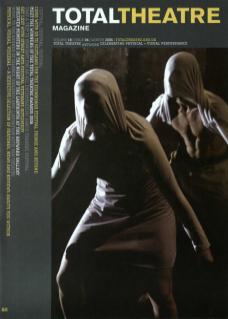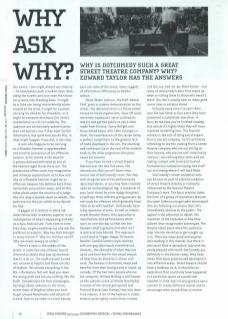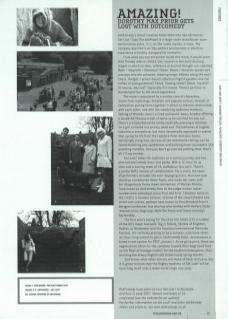Two smart – one might almost say smarmy – TV newscasters push a mobile news-desk along the streets and turn even the tiniest occurrence into breaking news. It might be a Coke can being intermittently blown around by the wind, it might be a parent carrying his child on his shoulders, or it might be someone who bears the tiniest resemblance to a B-list celebrity. The audience are occasionally asked to press their red buttons now if they want further information, but quite how you do this, or what might happen if you did, is not clear.
A man who happens to be carrying an inflatable hammer is apprehended and tried for possession of an offensive weapon. As he stands in the dock he is prosecuted and defended by two of the keenest legal minds there are. The prosecution offers some very imaginative and intimate explanations as to how and why an inflatable hammer might be an offensive weapon; the defence bats these outlandish accusations away, and all this takes place under the scrutiny of a judge who sits atop a wooden desk on wheels. The audience are the jury called on to decide his fate.
A gaggle of scientists in white lab coats follow their academic superior in an investigation of what’s happening and why on a busy festival site. From time to time they stop, single something out and ask the professor to explain: ‘Why has that man got so many tattoos?’ ‘Why are children small?’ ‘Why are aliens always on stilts?’
There’s a tent in the middle of the street. It looks like one of those tourist information desks that pop up whenever there’s a do on. The staff are well turned out, extremely helpful and there are lots of leaflets. Yet almost everything in the Mis-information Tent will lead you down the wrong path and tell you nothing like the truth. Competitions for free champagne, warnings about vultures on the loose, street maps of Brighton when you want to get around Manchester and details of a wind-farm to be sited in a local beauty spot are some of the many, many nuggets of information offered up as helpful advice.
Steve ‘Woko’ Jackson, the Half-Naked Chef, gives a cookery demonstration on the street. The demonstration is a thinly veiled excuse to insult vegetarians, show off some extremely unpleasant nylon underpants and try and get the public to eat a meal made from Doritos, Sunny Delight and those baked beans with little sausages in them, the tastelessness of the recipe being a perfect compliment to the general lack of taste displayed in the act. The alarming and continual rise in the cost of his cookery book as the show progresses also gives cause for concern.
If you have visited a street theatre festival over the last five years, the chances are that you will have come across one of dotComedy’s acts. You may well recognise one of the performances described above, or you may have chanced upon an archaeological dig, a makeover of your local street by some dodgy designers or perhaps three referees giving passers-by red cards for offences which generally have little to do with football. DotComedy have a big repertoire of work. As well as mobile street theatre shows, they specialise in installations and performances which carry on over the day so that the line between what’s genuine and what isn’t is well and truly blurred. This approach could lead to Trigger Happy TV/Jeremy Beadle/ Candid Camera style routines with one gag laboriously stretched out. However, the absurdity of what they are up to and their eye for the visual impact of what they do elevates it above such work. The humour is extremely sharp and benefits from their background in stand-up comedy. Of the two main people who run the company, William Wilding is well known on the cabaret scene as Woody Bop Muddy (creator of the record graveyard) and Richard Stamp (aka Stompy) has also done time indoors. A lot of the humour in street theatre quite rightly comes from context and the you-had-to-be-there factor – but many of dotComedy’s best lines stand up when re-telling them to those who weren’t there. You don’t usually hear so many good comic lines in outdoor shows.
Virtually every time I’ve seen them over the last three or four years they have presented a completely new show. In fact, by the time you’ve finished reading this article it’s highly likely they will have invented something new. This feverish activity is the sort of thing you’d expect from a live art company. So it’s extremely refreshing to see this coming from a street theatre company who are not sitting on their laurels, who are not self-consciously ‘artistic’, not refining their skills and not resting content with tried and trusted formulae but instead are trying new stuff out and seeing where it will lead them.
DotComedy’s street animation acts can be seen as part of a British tradition of street theatre directly or indirectly influenced by the Natural Theatre Company’s work. The basic premise takes the form of a group of characters dressed the same (often a recognisable stereotype) who are following a scenario that isn’t immediately obvious to the public. The appeal is the attention to detail, the invention of the costumes or how they subvert that recognisable stereotype. The theatre takes place when the audience step into the narrative or get caught up in it. There are many good and original acts working in this manner, but there is also much that is derivative, lazy and too easily pleased with itself. DotComedy are definitely in the former camp: they have taken that basic premise and developed it into different areas. Street theatre should have a boldness to it; it should be an experience that could only have happened in a particular space at a particular moment in time, but it’s also good to see a concern to create different moods and to encourage other possibilities to evolve.
Amazing! Dorothy Max Prior Gets Lots with dotComedy
DotComedy’s latest creation takes them into new territories: Get Lost! (aka The dotMaze) is a large-scale installation-cumperformance piece. It is, as the name implies, a maze. The company describe it as ‘the perfect environment in which to experience a healthy disregard for normality’.
From what you can encounter inside this maze, it would seem that Stompy and co. held a ‘yes’ session in the early devising stages in which no idea, reference or train of thought was rejected. Maze = labyrinth = Minotaur? Check. Mazes = fairytale quests and journeys into the unknown, meeting magic helpers along the way? Check. Hedges = privet-bound suburban English gardens and the follies of mad gardeners? Check. Potting sheds? Check. Topiary? Of course, why not? Especially if it moves. There’s an Alice-inWonderland feel to the whole experience.
The maze is populated by a motley crew of characters, drawn from mythology, fairytale and popular culture, threads of connection pulling them together in direct or indirect relationship with each other, and with the wandering audience members. Talking of threads, here’s a tired and world-weary Ariadne offering a would-be Theseus a ball of twine so he can find his way out. There’s a witchy Babushka enthusiastically pressing a talisman on a girl cornered in a privety dead end. The battiness of English suburbia is everywhere, but most dementedly expressed in scenes that spring to life from the Ladybird Peter and Jane books: terrifyingly overgrown versions of the wholesome siblings can be found munching jam sandwiches and bullying maze-journeyers into wrestling matches. And just don’t go into the potting shed, that’s all I’ll say on that.
Get Lost! takes the audience on a surreal journey, but has also led dotComedy down new paths. With a 12-hour fit up time and a touring team of 14, walkabout this ain’t. There’s a pretty hefty number of collaborators. For a start, the team of performers includes the ever-engaging actor, musician and stand up comedienne Helen Kane, who made her name with her dangerously funny clown re-invention of Marilyn Monroe (and known to dotComedy fans as the judge in their rather cumbersome walkabout piece Trial and Error.) Another name on the credits is Graeme Gilmour, veteran of the visual theatre and street arts scenes, perhaps best known as Shockheaded Peter’s designer/performer, but who has also worked with Welfare State International, Dogtroep, Walk The Plank and (most recently) Spymonkey.
The first year’s outing for the show has taken it to a number of the UK’s major festivals: Big in Falkirk, Streets of Brighton, Hatfair at Winchester and the Stockton International Riverside Festival. It’s certainly proving to be a success, with more-thanan-hour-long queues to get in (dotComedy folks, do introduce a timed ticket system for 2007, please!). As we go to print, there are negotiations afoot for the company to pack their bags (and load up the fleet of haulage trucks) for the southern hemisphere, thus avoiding the dreary English late winter/early spring months.
God knows what other nations will make of Peter and Jane, but it is great to know that the Blighty madness of Get Lost! will be launching itself onto a wider world stage very soon.
DotComedy have plans to tour Get Lost! to Australia and Asia in early 2007. Venues and dates to be confirmed (see the website for an update). For further information on Get Lost! and other dotComedy shows and projects, see www.dotcomedy.co.uk


